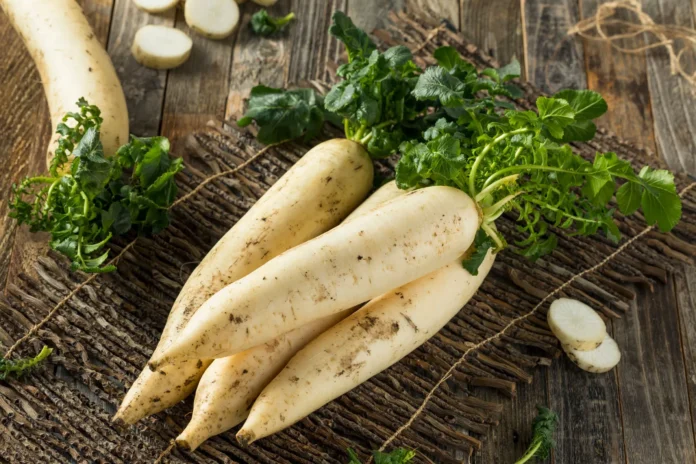Daikon, a type of radish native to East Asia, is a versatile and widely cultivated root vegetable. The name “daikon” originates from Japanese, meaning “big root,” which accurately describes its size and shape. Daikon is known for its mild flavor, crisp texture, and adaptability in various cuisines, especially in Japan, Korea, China, and Vietnam.
Interesting Facts About Daikon:
- Daikon is a type of radish scientifically known as Raphanus sativus var. longipinnatus. It is also commonly referred to as “mooli” in South Asia.
- It originates from East Asia and is a staple in Japanese, Korean, and Chinese cuisines.
- The name “daikon” means “big root” in Japanese, describing its large and elongated appearance.
- Daikon has a mild, slightly sweet flavor compared to the sharper taste of smaller radishes.
- It is incredibly low in calories, with about 18 kcal per 100 grams, making it a popular choice in weight-loss diets.
- Daikon is rich in vitamin C, aiding in immunity and skin health.
- It contains enzymes like amylase and diastase that aid in digestion, especially with starchy foods.
- The root has natural diuretic properties, helping to eliminate toxins and reduce water retention.
- Daikon leaves are also edible and contain more calcium and vitamin C than the root.
- It grows well in cooler climates and is typically harvested in winter.
- Daikon can be eaten raw, pickled, roasted, or stir-fried, showcasing its culinary versatility.
- It is often used in soups and stews due to its ability to absorb flavors.
- Pickled daikon, called “takuan,” is a traditional Japanese side dish.
- In Korea, cubed daikon is a key ingredient in “kkakdugi,” a type of kimchi.
- Daikon seeds are sometimes sprouted and used as microgreens in salads.
- The vegetable is known for its medicinal properties, helping with colds and respiratory issues due to its anti-inflammatory and antibacterial effects.
- It is cultivated globally but thrives particularly in Japan, China, Korea, and parts of Europe and the U.S.
- Different varieties of daikon exist, including round and cylindrical shapes, depending on the region.
- Daikon has been part of Asian agricultural practices for centuries, with evidence of its cultivation dating back to 500 BCE.
- It can grow to impressive sizes, with some roots weighing up to 20 pounds in optimal conditions.
- The vegetable can store well for weeks when kept cool and dry, making it a reliable food source.
- Daikon is a common ingredient in detox diets due to its ability to cleanse the liver and kidneys.
- Its fiber content promotes gut health and regular bowel movements.
- Daikon farming improves soil quality as the roots loosen compacted soils.
- The vegetable is also used as “green manure” in sustainable farming to enrich the soil with nutrients.
- In Japan, daikon radishes are sometimes carved into decorative shapes for traditional cuisine presentations.
- Its cultivation is relatively pest-resistant, making it easier to grow organically.
- Daikon can be used as a natural remedy for hangovers due to its enzyme content.
- The vegetable has cultural significance in Japan, often symbolizing simplicity and humility.
- Daikon has gained popularity in Western cuisine for its nutritional benefits and unique taste.
